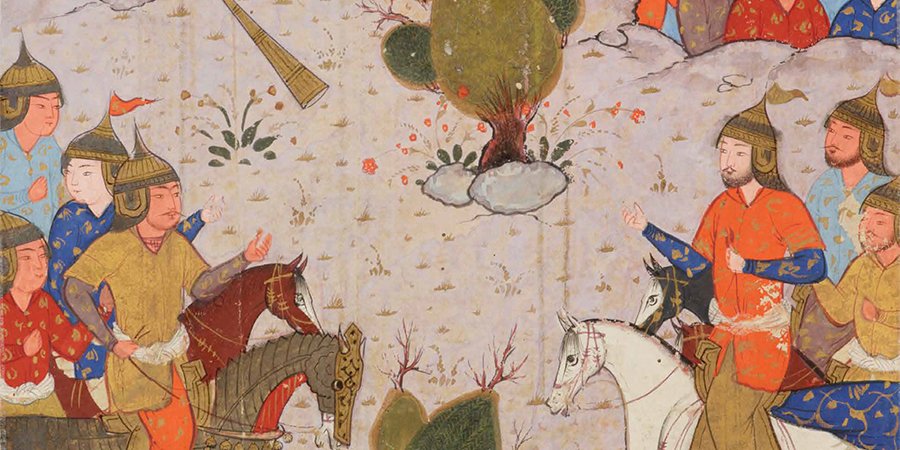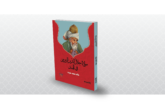
Persian Literature in the World literature
دراسة الأثر الفارسي في الادب العالمي
Maryam Kalati
Department of Foreign Languages – North Tehran Branch – Islamic Azad University – Tehran – Iran
مريم كلاتي
جمهورية إيران الإسلامية
جامعة آزاد الإسلامية – فرع شمال طهران – كلية اللغات الأجنبية
Abstract
The subject of the present research is in the field of comparative literature. It aims at studying and analyzing the effect of Persian literature, especially Maulana’s works, on the authors, thinkers, and translators. In the present study, it is attempted to know the great English and American literary figures who have provided outstanding works through translation or adaptation and they have played a great role in knowing the Persian literature and making it known in the English-speaking countries.
Maulana is the well-known Iranian poet and mystic of the seventh century hegira. He is mostly known for his mystic poems. He is indeed one of the great Sufi poets. His simple and appealing words are associated with a fervent love and zeal. His soft language and charming words arising from his broken heart express the mystic facts in a special way. His view toward allegories and mentioning different parables and tales while expressing a mystic subject has simplified the intentions of the khanqah’s hermits for the ordinary people(1).
Since the 18th century, Maulana Jalaluddin Balkhi’s Masnavi has been translated to various European languages, including and most specifically English. The process of translating Masnavi, alongside other poems of Maulana, has been accelerated over the last two decades. Given the wide range of fans of his works all over the world, the translation of Maulana’s works has been developed both in quality and quantity. However, these translations are not the same authority. The first English translations of Masnavi were done by Whinfield, Wilson, and Nicholson. These translations enjoyed a high level of accuracy and faithfulness. The contemporary translations, preferring words to sense, are seeking to attract more readers to the extent that some of them, such as Barks’ and Helsinki’s, are rewritings of the previous translations. One of the newest translations is a poetic one done by Mojaddedi. Being faithful and transferring the concepts to the maximum, this translation creates a better communication between Maulana and the English readers through the poetic techniques used in this version (2).
Introduction
One of the important features of the persistent works is their verbal and semantic dominance over the accepted and common standards of the time. They are by far ahead of their own time that dominates next centuries and sometimes go beyond the geographical borders. Various accounts and interpretations provided by persistent poems such as Nezami’s works, Masnavi Manavi, and Hafez poems all confirm this claim. Among the existing poetical works, the works of Shams Tabirizi, written by Jalaluddin Muhammad Ibn Balkhi, known as Mawlawi has an outstanding position. Being a main source of honor for the Persian Language and Literature, the poems and thoughts of Jalaluddin Mawlawi are like a gem whose ever-increasing beauty has mesmerized the world, and they still attract readers hundreds of years following his death:
بعد من صد سال ديگر اين غزل چون جمال يوسفي باشد سمر
(مولوي، 1378: غزل 1100)
Being greatly skillful and competent in writing poems, Mulana is one of the few literary figures that has criticized other poets as well. His criticisms are interesting to read and listen to; there are themes that are hard to find in other poets and thinkers’ works. Moreover, he is one of the rapturous and inebriated mystics who had composed poems in the state of rapture and inebriation that don’t follow the normal and conscious state of mind; it is during these states that the purest poems has been produced from his mind and inner self.
Jalaluddin Muhammad Ibn Balkhi known as Mawlawi, Maulana, and Rumi (30 September 1207 in Balkh– 17 December 1273 in Konya) is one of the most famous Persian poets (Greta Iran). His full name is Muhammad ibn-Muhammad ibn-Hussein Husseini Khatibi Bakri Balkhi. He was also known as Jalaluddin, Master, and Mulana the Master in his lifetime. In later centuries (apparently ninth century hegira), Mawlawi, Mawlawi Rumi, and Mullay-e Rumi have been used as well. Some of his pseudonyms include silent and speechless. His mother tongue was Farsi.
In introducing the Mawlawi studies, we must first mention Sir William (1746-1794). He ranked Masnavi eighth on the “works to read” list. In an account written on Masnavi, he states:
“It is likely that no such valuable book as Masnavi has been ever written so far. Its beauties and are equally amazing. It is a book full of ethical points, charming poems. It is replete with jokes and wits mocking the common sects of the time as well as sublime Persian sense. Masnavi is like an intact plain full of flowers in a favorable land. I do not know any author, other than Chaucer and Shakespeare, compared to Mawlawi (Luis, 2004: 694).
Mawlawi Studies has a long history in English-speaking countries, especially the United States. Mawlawi studies have been accelerated over the last decades, especially in the United States. (3) Reynold A. Nicholson and Arthur John Arberry have translated great works of Persian Literature and Mysticism, especially the commentary of Maulana Jalaluddin Muhammad Ibn Balkhi’s Masnavi. Today, after these scholars, Professor William C. Chittick is the most famous English scholar and thinker who has worked on Persian poetry and mysticism. Chittick has provided various works on mysticism, religion, and Mawlawi. Researches provided by Chittick are greatly accurate and helpful in understanding Maulana’s works. Apart from the old versions of Maulanal Jalaluddin Muhammad’s works, we can find some modern and updated versions of his works. One of these woks is a book written by Coleman Barks, the professor of English literature at the University of Georgia titled as The Essential Rumi published in 1996. This book was largely welcomed by the readers especially in the United States, and it was one of the poetry bestsellers. Being unfamiliar with Persian language, Barks rewrote some of the translated works of Mawlawi after getting familiar with Mawlawi. Using one of the unpublished translations done by one of his friends (Javad Moein) and encouraged by Sri Lankan Sufi (Baba Mahyeddin), Barks achieved a new version of Maulana. To adapt Mualana’s poems with the modern taste, Barks has excluded the mystic themes of that great literate from their historical and social origins; he has attempted to adjust them to the culture of the modern world.
Literary translation and its different versions
In translation studies, there are numerous discussions on the subject of equivalence, its nature, different kinds of equivalence, and the necessity of lack of necessity of equivalence. Equivalence (4) was first introduced by Nida (1964). He introduced translation as the reproduction of the closest natural equivalent, first in meaning and secondly in terms of style (quoted from Khosrowzadeh, 2012: 50). He maintains that there are two kinds of equivalence: formal correspondence and dynamic equivalence. It is natural that Nida favors dynamic equivalence; it aims at creating the same feeling and effect as created in the source text. Moreover, Newmark talks about semantic translation versus the communicative one. (5 & 6)
However, in all these definitions and classifications, one cannot find a valid criterion for identifying the different kinds of translation; all mention the equivalent effect. This will be more important in literary translation and especially poetry translation. For the identification of this criterion, one must first ask what the effectiveness strategies of poetry and literary texts are. In this regard, literary critics and semantic theorists have different views. However, if we merely pay attention to the common methods of the contemporary period and the reader-focused approaches, we must accept that the meaning of literary texts (and naturally their effects) is the outcome of the communication existing between the reader and the text. This meaning is produced in the reading process, and the reader’s attempts and even each reading can pave the way for creating a new meaning from a single text. However, since poetry deals with feelings, some maintain that feelings cannot be transferred through translation. It is recommended that no poetry translation is ever done, especially from poets like Mawlawi.
Mawlawi’s shining in the world
Mawlawi’s works have shone not only in Iran but also almost everywhere else in the world. As it was mentioned earlier, the regard given to this great Persian poet by the world’s great literary figures such as Lorca (the Spanish poet) and Borges (the Latin American author) is the best proof for Mawlawi’s international popularity. Lorca and Borges are only two examples for his worldwide fame. Moreover, millions of copies sold worldwide are another proof for the abovementioned claim. It is worth noting that Coleman Barks’ version of Masnavi has been one of the bestsellers of the recent decade in the United States.
Mawlawi’s popularity is not limited to the United States. He enjoys the same popularity in the European countries as well. Among the individuals affected by Maulana and his works we can refer to Professor Erric Geo Farri (great Mawlawi scholar), Alan Douglas (professor at the University of Georgia), Irma Garapin (professor at Aachen university), William Sarout (Oxford University Press Chairman), Dr. Stephano Palo (Mawlawi scholar and professor at the University of Venice), and Paulo Coelho (Brazilian writer).
Mawlawi’s methods of allegory
Maulana uses both methods of allegory very frequently and he is quite skilled in doing so. These two different kinds of allegory are called small allegory (or simile) and the large allegory (narrative allegory). Mawlawi’s thinking style is mind’s free and unrestrained style i.e., it is based upon recalling the meanings through a series of similes, ironies, anecdotes, and parables. It means that the ideas are derived from an analogic, philosophical, and mystic system that is at the same time highly artistic and poetic.
The first book of Masnavi starts with the allegory of reed flute. In this allegory discusses this mystic idea that human soul is part of soul of the universe (God) and chained in the body’s cage; it is willing to return to its original Self. Others have discussed this issue as well through different allegories. However, Mawlawi’s allegory is greatly poetic and eloquent. It is unlikely that one can find an Iranian who has not read the lines of this allegory.
Some of Mowlawi’s philosophical allegories
The Masnavi is replete with philosophical elegant thoughts on both general issues and specific ones. However, some of his allegories have discussed serious philosophical issues, and they are thus remarkable. Among the outstanding allegories, we can refer to the stories ‘the elephant in the dark’, ‘the ant and the letter’, and ‘the applicants of grapes’. These stories have not been created by Mawlawi himself. As it is noted in the valuable book written by(7) Forouzanfar (Masnavi’s Stories and Allegories) (Tehran, 1954), the story of the elephant in the dark, for example, has been previously quoted by Sanaei and Abu-Hayan Tawhidi (in Al-Muqabasat). The story of the ant and the letter has been mentioned by Ghazali in both Revival of Religious Sciences and The Alchemy of Happiness.
All these three stories deal with the theory of cognition. The story of ‘the elephant in the dark’ is about the people who gather to see an elephant brought by the Indians to be watched. Knowing only a little about the elephants, these people touch an organ of the elephant such as foot, ear, trunk, or back. They attempt to describe the elephant based on the organ touched; column, hand fan, drain pipe, and bed. However, their assumption of the elephant is a farfetched simile of the organs of the elephant; the elephant refers to something beyond these assumptions. One-sided and sensory cognition cannot understand the ‘whole’. These sensory touches will not result in full cognition.
Finding eloquent allegories is not an easy task. If we consider them as a guide for finding the logical reasoning, we apply a useful method, and we have made the understanding of the materials easier. To express the ideas intended, the exact sciences use allegory (commonly called Paradigm in Logic). Thus, one cannot claim that analogy is useless or fallacious in all cases.
Mawlawi and philosophy, science and reason
The relationship between Mawlawi and philosophy and advocates of philosophy that he refer to as “philosophical-logical/the abject” is quite clear. Reason and logic, philosophy and theosophy, and generally the sciences of that time are like great veils preventing the direct understanding. They all confuse the individual in endless superficial and formal discussions. Thus, being firm and decided in his own ideas, Mawlawi pursues his own beliefs and chooses his friends from the illiterate. Despite his disciples and friends’ strong disagreement, he chooses Salah al-Din Zarkoob as one of his friends and gave him the highest regards.
Comparing the poems with the English versions
The translation conducted by Nicholson is more accurate with respect to the meaning transferred. It has provided commentaries on the lines and couplets. However, it has attempted to transfer the meaning of the poems like the original poem. On the other hand, Mojadedi has provided a rhythmical translation with short lines and couplets. Like Persian pomes, Mojadadei’s version has managed to communicate well with the readers. However, the translation has failed to transfer the meaning intended. With respect to the meaning, the original poem does not correspond to the translation. However, given the short and rhythmical lines, the poems are rhythmical; they are similar to the original poems. The layout of original poem conforms to Mojadadi’s version; they are formally similar with rhythmical lines. In the formal structure of Nicholson’s poem, the lines follow each other without any space in a sentence-like format; it is radically different from the structure of the original poem. In Mojadadei’s version, the lines have been separated. In Nicholson’s version, some of the words have been placed in parentheses. Being separated has made the poems difficult to read. The extra words have been added as commentaries and explanations of the original poems and they are not needed to be used.
In Mojadadi’s version, there are some rhymed lines including ache-break, Unique-seek, love-above, say-way, clear-hear, knew-two, fate, demonstrate, and ray-way. Like the Persian pomes, one can find both rhyme and rhythm.
In the Persian poem, since the poems are amorous, one can easily see the alliteration of “sh” sound; it is dominant throughout the whole pomes. The repeated use of the word “eshgh” (love), as well as other words such as “asheghi” (lover), “Sharh” (commentary), “neveshtan” (write), “shetaft” (rushed), “rowshan” (clear and bright) indicated that there is an alliteration in the poem.
However, in the English version provided by Mojadadi enjoys the rhythm and appropriate layout; this rhythmicity is easily seen in the rhymes. The rhymes enjoy a poetic musicality. The poems, however, have sacrificed the meaning for the sake of form; this has resulted in confusion, and the meaning has not been transferred properly.
As for the translation of the word “dard” (pain), Mojadadei has used ‘ache’, and Nicholson has used ‘soreness’. The word soreness is a better equivalent; it enjoys a non-physical aspect and suits more appropriately in Maulan’s context and poems. Moreover, the original meaning of the poem, that is appearing and revealing, is better transferred through Nicholson’s translation, and the meaning has been transferred accurately. In the third line, the poet aims at discussing the main reason behind the separation. In the translation provided by Mojadadi, the translator talks about the uniqueness of separation. Given the general commentaries provided, Nicholson’s version has managed to do so more successfully. In the fourth line, God’s secrets has been rendered literally in Nicholson’s translation; this is much better than the equivalent provided by Mojadadi as “quest”. In the fifth line, no specific audience is addressed. However, in the version provided by Mojadadi, ‘You’ has been used as the addressee. By experiencing the feeling of ‘love’, given the mystic poems of Maulana, both heavenly and earthly love are considered as the main criterion, and thus they have been given due attention in Nicholson’s version. However, in the sixth line where it has mentioned ‘rahbar’ (leader), the word has been translated as ‘destined’ in Mojadadi’s. It has been translated as ‘lead’ that has transferred the meaning more appropriately. Moreover, the word ‘yonder’ transfers the meaning of beyond and far much better. Mojadadi’s translation of line seven and eight has managed to preserve the poetic meaning, rhythm, and form. Nicholson’s translation is good enough as well, but it suffers from the commentary that does not correspond to the original form of the poem. Although Mojadadi has transferred the meaning, the context, and the form of the ninth line, he has mistranslated the tenth line by translating the silent love as the real love, and this has made the translation problematic. Moreover, in the original poem, love is expressed as something clear. However, in Mojadadi’s translation, it’s being expressed as a ‘listener’, and this results in a semantic paradox. In Nicholson’s version, it is stressed that love is something clear and obvious, and thus ‘bi-zabani’ (tongueless) has been translated word by word. However, Mojadadi has translated it as silence. In Mojadadi’s context, the meaning has changed, and this is not acceptable.
In translating the 11th line, “Whilst the pen was making haste in writing”, Mojadadi has not provided an accurate translation of both form and meaning. This is followed by the word ‘know’, and the meaning is not transferred in the translation. However, form and the meaning of the twelfth line has been translated better by Mojadedi. Nicholson has translated it by using commentary and word by word by saying “it split upon itself as soon as it came to Love”. He has added the phrase ‘as soon as’, while he had used ‘whilst’ in the previous line.
In line thirteen, Nicholson aims at expounding love. Love has been placed in the parenthesis; this is done to provide a commentary on this line. However, formally speaking, this line is problematic. The word ‘helplessly’, used for expounding helplessness, has been placed in parenthesis as well; its meaning has been expanded and developed. However, Mojadadi has failed to translate this line. Mojadadi has provided an acceptable translation of the fourteenth line. Mojadadi’s translation of the fifteenth and sixteenth line is committed to both meaning and form. Nicholson’s version, transferring the meaning literally and word by word. Using parentheses is not needed for providing extra explanation.
Conclusion
Given studies conducted on the formal criteria and figures of speech, one cannot reach an absolute conclusion about translation. However, given the findings of the present study, we can mention some issues in poetry translation.
In translating the original poem, the typography is one of the criteria that needs to be paid due attention. The original poem enjoys rhyme and poetic musicality, and the words are selected in such a way that affect the meaning as well. However, in Nicholson’s translation this is not preserved. Mojadadi has attempted to do so. In Mojadadi’s translation, the form has been sacrificed for the sake of the meaning. While in the version translated by Nicholson, it has been attempted to transfer the meaning of the original poem through providing extra explanation and commentaries. However, Nicholson has failed to reproduce the poetic form of the original, i.e. he has been faithful to the original meaning through producing a form that does not correspond to the original with respect to musicality, rhyme, and appropriate alliteration. In Mojadadi’s translation, the musicality of the poem has been preserved. However, it has failed to transfer the original meaning. He has been faithful to the form; the reader’s passion and emotion are aroused through ignoring the original meaning. However, in Nicholson’s translation, the reader’s feeling is aroused through the meaning transferred. However, there is no musicality and feeling in the poem, and this makes the reading process difficult. Since poetry deals with feelings, some maintain that feelings cannot be transferred through translation. It is recommended that no poetry translation is ever done, especially from poets like Mawlawi. It is true that expressing the tempo of the poem is not possible, but literary translation needs to be taken into serious account. Those talking about the untranslatability of Maulana’s poem or the mere transfer of his ideas, are not familiar with literary translation. If there is a literary charm and elegance in the target language, the target text reader will easily understand the beauty of the words.
Translations such as that of Nicholson are closer to Maulan’s words. When you are reading the works of Shams-e Tabrizi or Kabir, you will face amazing lines and couplets in every sonnet; one can claim that they are revolutions in the language. These wonders of the language expands throughout the sonnet. It seems more logical and practical to think of the relativity of expressing emotions, translating poetry, and accepting the translation through knowledge, attempt, and innovation; nothing should be seen as absolute.
الملخص
موضوع هذا المقال في مجال الأدب المقارن و تحليل تأثّر الأباء، المفكرين و المترجمين من آثار الأدب الفارسي خاصة آثار جلال الدين الرومي. لقد حاولنا في هذه الدراسة أن نتعرف علي أدباء اللغة الإنجليزي و الأمريكية الذين قدموا مساهمات هامة من خلال الترجمة أو التكيف (الاقتباس) وسعوا في التعرف و تعريف الأدب الفارسي لاسيما شعر الرومي، في البلدان الناطقة باللغة الإنجليزية.
الرومي هو الشاعر و العارف الإيراني الشهير في القرن السابع الهجري. معظم سمعة الرومي في قصائده الصوفية، إنه عالم حقيقي من الشعراء الكبراء الصوفية. و ترافق كلماته البسيطة و الحب و حرق العاطفة و لسانه اللطيف و كلامه الممتع الذي ينبع من قلبه المحترق و العاشق و الواله، يستبدل حقائق التصوف بشكل خاص في القلوب و رأيه و اهتمامه إلي التمثيلات العديدة و إلقاء الحكايات المختلفة عند طرح موضوع عرفاني، يكشف بوضوح أكثر و أفضل، نوايا معتكفي الأديرة لعوام الناس. ترجم من القرن الثامن عشر حتي الآن عدة مرات كتاب المثنوي الشريف لمولانا جلال الدين البلخي إلى العديد من اللغات الأوروبية، خاصة الإنجليزية. وقد تسارعت عملية ترجمة المثنوي جنبا إلى جنب أشعار الرومي الآخري طيلة العقدين الماضيين، حيث من جهة الكمية و النوعية و من جهة عدد كبير من محبّي الرومي وهُواته في جميع أنحاء العالم وصل هذا الكتاب إلي موقف فريد من نوعه. و هذه الترجمات بالطبع، ليست في المستوى الواحدة. أسبق الترجمة الانجليزية للمثنوي كترجمة «وينفيلد» و «ويلسون» و «نيكولسون»؛ كانت أكثر دقة و ثقة و الترجمات المعاصرة مع رجحان اللفظ علي المعني، تهدف إلي جلب اهتمام المزيد من المخاطب حيث لتستعملْ كلمة «إعادة الكتابة» بدلا عن «الترجمة» لبعض من روايات المثنوية الأخيرة باللغة الإنجليزية علي سبيل المثال «باركس» و «هلسينكي». ترجمة “مجددي” أحد أحدث الآثار المكتوبة في مجال ترجمة المثنوي المنظومة. هذه الترجمة مع مراعاة الأمانة و نقل أكثر مفاهيم الكتاب، بسبب مراعاة النمط الشعري تُقيم العلاقة أكثر مرجوّة بين الرومي و المخاطب المتحدث باللغة الإنجليزية.
Mojaddedi’s translation
“Being a lover means your heart must ache,
No sickness hurts as much as when hearts break,
The lover’s ailment’s totally unique,
Love is the astrolabe of all we seek,
Whether you feel divine or earthly love,
Ultimately we’re destined for above.
To capture love whatever words I say
Makes me ashamed whenever love arrives my way,
While explanation sometimes makes things clear;
True love through silence only one can hear;
The pen would smoothely write the things it knew
But when it came to love it split in two,
A donkey stuck in mud is logic’s fate,
Love’s nature only love can demonstrate:
Sunshine reveals its nature in each ray,
So if it’s proof you want just look this way!”
Nicholson’s translation (8)
“Being in love is made manifest by soreness of heart: there is no sickness like heart-sickness.
The lover’s ailment is separate from all other ailments: love is the astrolabe of the mysteries of God.
Whether love be from this (earthly) side or from that (heavenly) side, in the end it leads us yonder.
Whatever I say in exposition and explanation of Love, when I come to love (itself) I am ashamed of that (explanation).
Although the commentary of the tongue makes (all) clear, yet tongueless love is clearer.
Whilst the pen was making haste in writing, it split upon itself as soon as it came to Love.
In expounding it (Love), the intellect lay down (helplessly) like an ass in the mire: it was Love (alone) that uttered the explanation of love and loverhood.
The proof of the sun is the sun (himself): if thou require the proof, do not avert thy face from him!” (Masnavi I: 109-116)
References
1. Maulana, J.M.B. (1382). Mathnavi Manavi based on Nicholson. Tehran.
2. Mojaddedi, J. (2004). Mathnavi Manavi. Oxford University.
3. Nicholson, R. (1977). The Mathnavi of Jalalu ddin Rumi. London: Gib Memorial.
4. Nida, E.A. (1964). Toward a Science of Translating, Leiden: E.J.Brill.
5. Newmark, P. (1988a). A Textbook of Translation. Hertfordshire: Prentice Hall.
6. Newmark, P. (1988b). Approaches to Translation. Hertfordshire: Prentice Hall.
7. Forouzanfar, B. (1954). Masnavi’s Stories and Allegories. Tehran.
8. Nicholson, R. (1898). Selected Poem from Diwane Shams Tabrizi.



